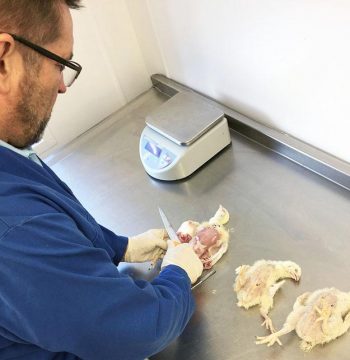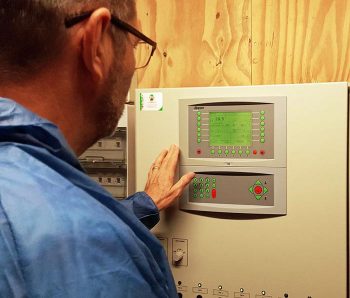27 Nov 2017
Daniel Parker provides an overview of how he ended up in the poultry sector of veterinary practice and the misconception over what such a job role actually entails.

Checking birds’ health.
I was brought up on a mixed (predominantly dairy) farm in Cornwall and, being the youngest of three boys, knew from an early age I wasn’t going to end up farming it. Being a farmer’s son while dabbling with the idea of being a small animal orthopaedic or soft tissue surgeon, the forthright reviews from my college lecturers in those subjects soon put an end to those delusions of grandeur.
So when I graduated in 1983, I was fairly sure I would end up predominantly working in farm animal practice, and so it transpired that I started my veterinary career at Tuckett, Gray and Partners in Aylesbury, Buckinghamshire, in the farm animal department.
While I got some exposure to pig work, the majority of my day was taken up with cattle work, and I could sense that was the direction I was heading. A move to Shepton Mallet in Somerset to work in dairy practice under the tutelage of Roger Eddy seemed to confirm that direction of travel.
However, some things in life don’t quite work out as you expect, and I found myself taking a break from large animal work to travel to the Far East and work with small animals in Hong Kong. A six-month break soon turned into four years and, by 1997, the hand back of the colony of Hong Kong to the Chinese was rapidly approaching. It was time to get a proper job.
However, rather than coming back to the UK to work in practice, I applied to pharmaceutical companies to work in their technical teams. I was offered a job with Intervet (UK) providing technical service for its poultry biologicals. This would be my introduction to the UK poultry industry. While we had poultry industry lectures at vet school, I – like most of my classmates – did not register the scale of it, or its vet opportunities. At that time (the early 1990s), the UK poultry industry had significant viral disease challenges, such as very virulent Marek’s disease, very virulent infectious bursal disease, turkey rhinotracheitis and variant infectious bronchitis disease.
The vaccines licensed in the UK did not provide adequate protection against these disease strains; however, biological products were available in Europe. The challenge was to convince the UK licensing authorities these products were safe and efficacious, so much of my work was involved in field trials and technical support for these products.
So, as well as being employed, I had the additional bonus of being given wide exposure to most areas of poultry production, which really whetted my appetite for the sector. While I had the option to progress within the pharmaceutical industry, my real interest lay in the production sector, so when the opportunity arose to return to clinical practice, I took it.
In 1995, I joined Hellig and Jones – an exclusive poultry practice in Colchester – with the prospect of buying the practice goodwill within the year. The client base was strongly biased to the poultry meat sector and included a primary breeding company supplying breeding stock worldwide. In 1996, I bought the goodwill and set up Slate Hall Veterinary Practice in Cambridge.
In the early days, when endemic disease levels were higher, much of the work was laboratory based, with samples of dead or culled birds being submitted to the practice for postmortem and diagnosis. Diagnosis of classic poultry diseases, such as infectious bursal disease and Marek’s disease, was relatively simple as the gross pathology was pathognomonic. If required, further samples might be submitted for bacterial, viral or histological investigation.
When the diagnosis was made, treatment would be advised and dispensed. Additional hygiene and vaccination advice would be given to the client to prevent disease in the next flock of birds placed on the farm.
In addition to diagnostic work, the practice undertook a lot of routine health monitoring, screening for both Salmonella and Mycoplasma.

Endemic disease in UK poultry flocks is now better controlled, thanks to building and equipment investment, stockman training, improved hygiene and biosecurity standards, and a broader effective vaccine range. The vet focus is now on improved production efficiency, welfare and managing responsible medicine use.
Achieving improved production parameters is more “multifactorial”; therefore, the diagnostics are more complex and more veterinary time is spent examining the interaction of birds with environment, management and feed.
However, a broiler company rearing one million broilers per week (with an average feed price of £260/tonne) stands to lose about £6,000 per week if feed conversion ratios move from 1.54 to 1.55. So, while laboratory-based postmortem examination is still a part of the daily routine for a poultry vet specialist, much greater time is spent on production farms, hatcheries and processing plants.
Welfare legislation has changed significantly over the years, which has raised welfare standards across the sector. Welfare indicators, such as contact dermatitis and carcase condemnation rejects, are measured at the processing plants. Interrogation of those figures enables the production vet, in concert with the official vet, to target farms with poorer welfare scores and develop plans to improve the on-farm welfare.
The past few years have brought increasing focus on antibiotic usage in all production animal sectors. The poultry meat sector has made significant reductions in usage (71% in four years) and poultry vets have played an important part in this by actively managing usage and supporting cultural change.
When I first set up Slate Hall, the work for the primary breeding company customer was mainly related to technical support. A breed company customer would have a problem with the stock he or she had purchased, such as a mortality issue or underperformance of the stock compared to breed standard. I would be part of the technical support team sent to visit the customer, investigate the problem and advise changes to provide solutions. These trips were interesting culturally and professionally.
While chicken stock and chicken people are, in general, the same worldwide, production systems may be different. An example of a difference would be feed raw materials. In most parts of the world, chicken diets are based on maize, while in the UK, they are based on wheat. Housing would be different, adapted to climate and custom – for example, in Russia I saw broiler breeders housed in cages and all fertilisation was undertaken by AI. The opportunities to see different housing, management and feeding systems worldwide was an invaluable learning process and provided a wealth of experience – some of which could be applied in the UK to drive improvements. Also, the exposure to different cultures, food and beverages was, as my mother would say, “character building”. However, I’d rather not have to fly in an Aeroflot Tupolev with its folding seats ever again…

While I have no direct experience, other career opportunities are available for vets with poultry expertise – in government, universities and research. The epizootics of avian influenza H5N8 have highlighted the importance of expertise in these areas to the UK and international poultry sector.
The indications are we will see further developments and incursions of these exotic diseases into domestic poultry populations and need the scientific capability to help track, control and provide solutions. Food safety and security is important to all governments and, since poultry meat is a significant proportion of the global animal protein supply, a need will remain for poultry specialists to provide safe nutritious food at an economic price.
Now, I realise most aspiring young vets would not consider the poultry industry the most glamorous or exciting sector. For years I think that was the case, compounded by the “closed door” approach of many poultry producers and the lack of time dedicated in the university curriculum to poultry medicine and production.
Public perception is of factory farming and dark, dingy, airless buildings with poor welfare, and I can understand young vets starting out would not want to be associated with this. However, that is not the modern day reality.
The sector is innovative and highly technical; it’s almost standard for the sector to have windowed sheds with natural light and enrichment to provide stimulation to the birds. The industry does have strict biosecurity standards, which limits access, but this is imperative to control disease. While criticism may occur from some quarters – implying the poultry industry is failing to be transparent by hiding behind the mantra of biosecurity – perhaps if other animal production sectors followed similar standards on biosecurity, better control of endemic disease would exist.
Agreed, we don’t have fancy toys, such as CT scanners or internal fixation Instrumentation, but we do have interesting caseloads, and knowledgeable and challenging customers. If population medicine and epidemiology “float your boat”, maybe the poultry sector can fulfil that interest.
Various channels to enter the sector exist – pharmaceutical, breed and nutrition companies; government service; and private practice. So, next time you see an advert in Veterinary Times or on https://jobs.vettimes.co.uk for a poultry practice position, think again – you may be surprised where it leads.